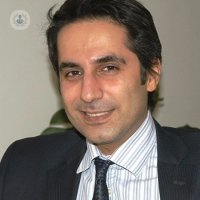What is RefluxStop?
Written in association with:Consultant bariatric & gastrointestinal surgeon Mr Majid Hashemi explains RefluxStop, including how candidates can be determined for the surgery and how to insert the device.
How do you determine candidates for RefluxStop?
Before determining a definitive treatment for a patient’s reflux, we have to confirm the diagnosis. There are a number of investigations that we carry out in order to do this, such as endoscopy or physiology. Sometimes we do this with an X-ray in the form of a barium swallow. Some patients may need some additional investigations, but it's essential to get the diagnosis.

Secondly, we want to be sure that the diagnosis is the cause of the symptoms and alongside this, through history and the examination, we've ruled out other diseases that could be co-existing with their presentation.
I believe that medical treatments and conservative management can be tried. However, these cannot repair the sphincter which is weak and damaged, or repair a hiatus hernia, which is an anatomical problem. We therefore offer a range of surgical treatments which definitively and conclusively correct the reflux, preventing further injury to areas such as the lungs, oesophagus, trachea and voice.
Who is a suitable candidate for RefluxStop?
In terms of selection criteria, it can be applied to any patient, whether they have a small or large hiatus hernia, or have good motility or bad motility. Our colleagues in Europe have done trials with RefluxStop in a whole range of patients and have had no dysphagia with it. They have had positive results with good efficacy and control of reflux.
We are rolling it out now in the UK. The investigations for this are exactly the same as they are for any other patient. The selection criteria involves the usual risk vs benefit analysis. The difference is that the risks of bloating or difficulty in swallowing are going to be less, therefore it can be applied to a bigger group of people, specifically those with bad motility.
How is the RefluxStop device fixed on the stomach?
RefluxStop is a new device. It has been trialled and assessed and confirmed to be safe in Europe and there are also some UK centres that are now doing it regularly. It's implantable and placed inside the abdomen.
To insert it, you still need to have the operation as with the Fundoplication and the Linx. This is done as a keyhole operation, in exactly the same way through five holes in the abdominal wall, generally small five-millimetre holes.
The next step is the reinforcement of the sphincter. In traditional cases, we use the stomach or the Linx. In this case, what we do is create a pocket in the upper stomach using stitching. We stitch at the upper end of the stomach and lower oesophagus and we invaginate this into the little pocket we've created.
It sits alongside the stomach, but not around it. The theory behind the invention was that because it's not sitting around the stomach or the trophagus, it won't cause dysphagia. People can eat and drink as normal. What we found, is that the patients who've had this do not get dysphagia.
The surgery that we offer is keyhole takes about an hour to an hour and a half in a straightforward case. The more complex or revision cases can take longer.
What risks are associated with RefluxStop?
Every individual has their own risks, and there are two side effects with the operation. They are not common, but without question, there is always an inherent risk.
During the procedure, doctors are putting a ring, a mechanical device at the lower end of the oesophagus, which will prevent the reflux from coming up.
However, it may also prevent air from coming up, meaning that patients can get bloated, as well as food fertility. Bulky food such as bread or steak may be difficult to swallow and digest. Whether that ring is made from the stomach itself in the form of a Fundoplication or the Linx device, it's still a ring and it can, in theory, cause those side effects even when it's doing its job very effectively.
Is RefluxStop currently widely administered?
In my practice, I am administering RefluxStop only to patients where their motility is compromised or if they particularly want it because it is new. As doctors, we must be very, very selective with our first cases. We want the patients to do well and double down on everything. We will look very carefully at the physiology etc and administer this for patients who I think or know will benefit from RefluxStop, such as ones where the motility is weak, where they actually don't have enough contractions in the oesophagus to push the food and liquid through.
Quite often these patients will end up not getting any surgery. They're often told by medics “We’ve done our best, go on medication, sleep upright and don't eat big meals”; things which are very, very difficult to actually do and have limited effect.
It gives a whole group of patients access to a treatment that they would otherwise not be able to get.
It doesn't mean that it's just for people with poor motility, but those are the ones where we know they will improve in terms of correction of the reflux, fixing their hypotonia and where this can give them an operation where they don't get that dysphagia, whereas the links or the Fundoplication or at least the fuller Fundoplication quite often would not be an option for them.
In time, once we get very comfortable with that, we will increase the catchment for this operation.
If you would like to book a consultation with Mr Hashemi, you can do so by visiting his Top Doctors profile today.


